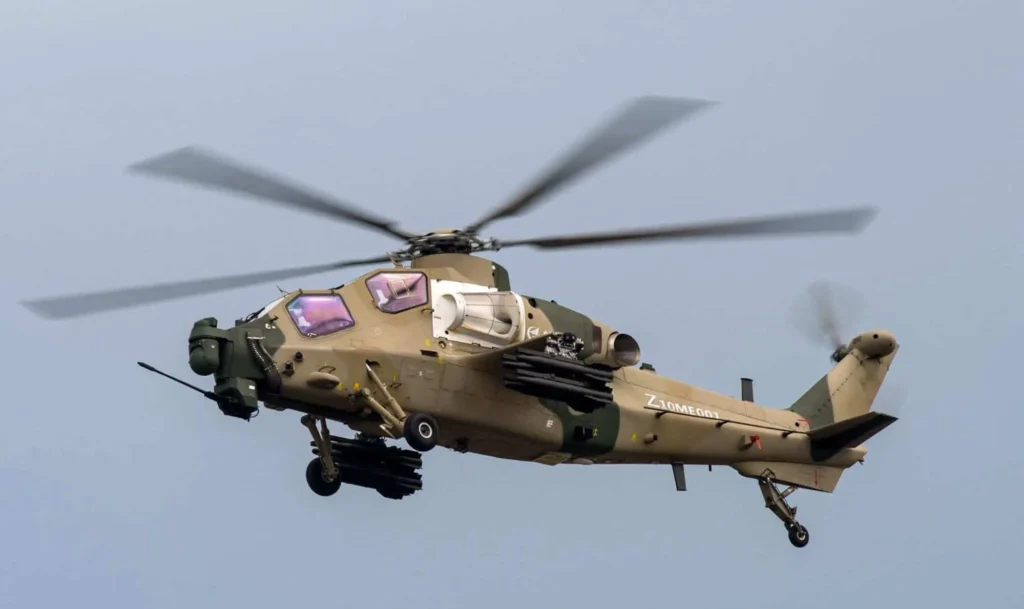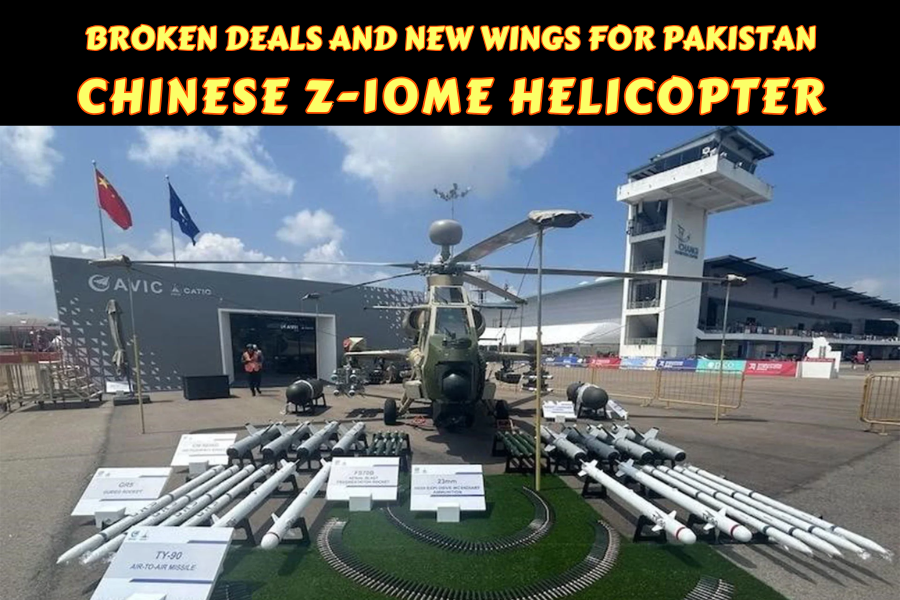(By Khalid Masood)
I. Introduction
Pakistan’s pursuit of military modernization is a cornerstone of its strategy to ensure maritime security, CPEC security, and regional deterrence, particularly in the context of asymmetric warfare and tensions with India. Central to this effort is the Pakistan Army Aviation Corps (PAAC), which relies on attack helicopters for anti-tank warfare, counter-terrorism operations, and close air support along the Line of Control (LoC). In 2018, Pakistan signed a landmark $1.5 billion deal with Turkey for thirty T129 ATAK helicopters, only to see it collapse due to U.S. export controls. This setback prompted a pivot to China’s Z-10ME helicopters, reflecting deeper Pakistan-China defence cooperation and China-Pakistan Economic Corridor (CPEC) ties. This article examines the failed T129 deal, the shift to Z-10ME, and its implications for Pakistan’s defence strategy, Pakistan-Turkey relations, and the regional balance in 2025.
II. The Turkish T129 ATAK Deal: Ambitions Grounded
In July 2018, Pakistan and Turkish Aerospace Industries (TAI) signed a $1.5 billion contract for 30 T129 ATAK helicopters, marking Turkey’s largest defence export. The T129, a variant of the AgustaWestland A129 Mangusta, is a twin-engine, tandem-seat helicopter designed for high-altitude anti-tank warfare and counter-terrorism operations. Equipped with a 20mm turreted gun, UMTAS anti-tank missiles, Cirit laser-guided rockets, and up to 76 70mm rockets, it excels in hot and rugged terrains like Pakistan’s Khyber Pakhtunkhwa and Balochistan. Extensive trials in 2017 and a showcase at the 2018 Pakistan Day Parade confirmed its suitability for PAAC needs, aiming to replace ageing AH-1F Cobra helicopters.
The deal relied on LHTEC CTS800-4A engines, co-developed by Honeywell (U.S.) and Rolls-Royce (UK). However, U.S. export controls, citing Turkey’s purchase of Russian S-400 systems and concerns over Pakistan’s enhanced capabilities against India, blocked engine export licences from 2018 to 2022. Despite extensions until 2021, Pakistan cancelled the deal in January 2022, with Major General Babar Iftikhar stating, “We have moved on”.

III. U.S. Export Controls: Geopolitics Over Technology
U.S. export controls derailed the T129 deal, reflecting broader geopolitical tensions. Washington’s refusal to grant licences stemmed from Turkey’s S-400 acquisition, which led to U.S. sanctions under CAATSA in December 2020. Additionally, U.S.-Pakistan relations soured post-Afghanistan withdrawal (2021) and FATF scrutiny over Pakistan’s counter-terrorism financing, limiting access to U.S. military hardware like the AH-1Z Viper. U.S. lawmakers also feared the T129’s capabilities could bolster Pakistan’s ground attack potential against India, a key U.S. ally.
This was no mere technical formality but a political snub, straining Pakistan-Turkey relations and exposing NATO-Turkey disappointment. Pakistan’s military, wary of U.S. supply disruptions in potential India conflicts, sought alternatives. The cancellation underscored the risks of relying on multinational components, pushing Pakistan toward China for defence cooperation and indigenous defence capability.
IV. Enter the Dragon: Pakistan Eyes Chinese Z-10ME Helicopters
The Z-10ME, an export variant of China’s Z-10, emerged as Pakistan’s alternative. Featuring WZ-9G engines, enhanced composite armour, infrared suppression, and advanced electronic warfare (EW) suites, the Z-10ME offers robust anti-tank warfare capabilities. It carries a 23mm chain gun, HJ-10 anti-tank missiles, TY-90 air-to-air missiles, and 57mm rockets, with a 70 km-range CM-501XA loitering munition, surpassing Israel’s Spike NLOS (45 km). Its avionics and targeting systems support day/night operations, ideal for Pakistan’s diverse terrains.
Compared to the T129, the Z-10ME is less proven in high-altitude environments but benefits from upgraded engines and lower costs. Pakistan’s choice reflects China’s reliability as a supplier, deepened by CPEC ties and joint ventures like JF-17 Thunder production. Negotiations since 2020 culminated in planned deliveries for 2025, with up to 40 units speculated. China’s offer of technology transfer and potential local assembly aligns with Pakistan’s indigenous defence capability goals.

V. Strategic Implications for Pakistan
The Z-10ME acquisition enhances Pakistan’s autonomy in arms procurement, reducing dependence on Western tech prone to sanctions. For PAAC, the helicopters bolster air mobility and counter-terrorism operations in FATA and Balochistan, where AH-1F Cobras struggle at high altitudes. The Z-10ME’s anti-tank capabilities, with HJ-10 missiles, strengthen deterrence along the LoC and international border, countering India’s armoured units. Reports suggest Pakistan is exploring local assembly in Kamra or Taxila, potentially integrating Turkish munitions like UMTAS or Cirit rockets, leveraging Pakistan-Turkey relations.
This shift aligns with CPEC security, protecting Gwadar Port and maritime security routes critical to China-Pakistan Economic Corridor trade. By diversifying suppliers, Pakistan mitigates risks seen in U.S. and Houthi drone attack disruptions, ensuring operational readiness for asymmetric warfare scenarios.
VI. Regional and Global Reactions
India perceives the Z-10ME acquisition as a response to its 156 LCH Prachand helicopters, designed for high-altitude anti-tank warfare along the LoC and Ladakh. India’s military response may include accelerating AH-64E Apache deployments or enhancing Prachand production, intensifying the South Asian arms race. NATO and Turkey express disappointment, as the T129 cancellation weakens Pakistan-Turkey defence cooperation, though talks for joint helicopter development persist.
China’s role strengthens Pakistan’s defence doctrine, emphasizing self-reliance and CPEC integration. Beijing’s supply of Z-10ME and potential J-35 jets positions it as Pakistan’s primary arms partner, countering U.S. influence.
VII. The Future of the T129 in Pakistan
While Pakistan cancelled the T129 deal in 2022, the door remains ajar. Turkey’s TEI-TS1400 indigenous engine, successfully tested in 2023 on the T625 Gökbey, could replace the LHTEC CTS800-4A, potentially reviving the deal. Ankara’s diplomatic efforts with Washington, including F-16 sales progress in 2024, aim to ease U.S. export controls. However, Pakistan’s pivot to China and negotiations for Z-10ME local assembly suggest a long-term shift, with Turkey likely relegated to secondary roles like munitions integration.
VIII. Lessons Learned and the Road Ahead
The T129 saga underscores the risks of multinational components in defence tech. U.S. export controls exposed Pakistan’s vulnerability to geopolitical whims. Pakistan’s push for indigenous defence capability, seen in JF-17 and VT-4 tank production, must expand to helicopters, potentially via Z-10ME assembly. Diversifying suppliers like China, Turkey, and exploring Russia’s Mi-28 in order to mitigate risks, aligning with Pakistan strategy and CPEC security needs.
Pakistan’s defence strategy should prioritize:
- Local production: Establish Z-10ME assembly lines to reduce costs and enhance self-reliance.
- Technology transfer: Leverage China and Turkey for avionics and munitions expertise.
- Regional diplomacy: Balance OIC ties with Saudi Arabia and Iran to secure maritime security and CPEC routes.
IX. Conclusion
Pakistan’s pivot from the Turkish T129 ATAK to Chinese Z-10ME helicopters reflects a strategic recalibration amid U.S. export controls and regional tensions. The Z-10ME enhances PAAC’s anti-tank warfare and counter-terrorism operations, supporting CPEC security and maritime security. While India’s Prachand acquisition escalates competition, Pakistan’s deepened defence cooperation with China and Turkey fosters autonomy. The T129 deal’s collapse highlights the perils of Western tech reliance, urging Pakistan to prioritize indigenous defence capability. In 2025, Pakistan’s balancing act like diplomacy, defence, and autonomy will shape its role in South Asia’s evolving security landscape.







